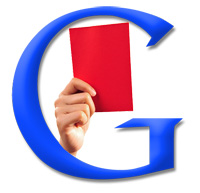Google Now Reports “Practically 100%” Of Manual Actions
Wondering if some human at Google has reviewed your web site and decided it deserves to be penalized in Google’s search results? Google’s now reporting such cases nearly 100% of the time. “We’ve actually started to send messages for pretty much every manual action that we do that will directly impact the ranking of your site,” […]

“We’ve actually started to send messages for pretty much every manual action that we do that will directly impact the ranking of your site,” said Matt Cutts, the head of Google’s web spam team, when speaking at the Pubcon conference this week.
“If there’s some manual action taken by the manual web spam team that means your web site is going to rank directly lower in the search results, we’re telling webmasters about pretty much about all of those situations,” he continued.
Cutts said there might be a rare “corner case” that might not make it but that reporting is “practically 100%” and “the intent is to get to 100%, and as far as I know, we’re actually there.”
It’s very similar to what Cutts said when speaking at SMX Advanced this June. Then, he gave a 99% figure. Now, the rounding is up to 100% and is even more noteworthy to highlight.
It’s a good time to review the two types of actions that Google has: manual and algorithmic. Google also refers to them as “actions” rather than penalties, even though for most impacted by these, they’ll feel like a penalty, because they may rank lower, often dramatically so.
Manual Actions
With a manual action, some human being at Google has reviewed a site and decided to issue a penalty against it (usually manual actions are indeed penalties). The review might be triggered by a spam report from an outsider or just Google’s regular policing.
Removing manual penalties often involve the targeted site filing a reconsideration request along with showing a good faith effort to correct a problem. For example, last year, JC Penney was hit with a 90 day penalty for paid links. It made an effort to clean up those links, submitted a reconsideration request and the penalty was eventually removed, deemed “tough and the appropriate length,” as Cutts said last year.
How do you know if you have a manual action? This should be reported to you through Google Webmaster Central, if you’ve verified your site there.
Algorithmic Actions
With an algorithmic action, Google’s assessed what feels like penalty against a site through an automated means. In other words, something with the site is causing Google’s computer algorithms to prevent the site from ranking as high as it could.
“Feels like a penalty?” I know, but Google’s adamant that algorithmic actions aren’t penalties but rather simply part of how Google ranks sites overall. Indeed, Google has a wide variety of factors it uses to determine how well any page should rank. Sites that please the algorithm do well; those that don’t get less visibility. That’s SEO 101.
But for almost two years now, Google’s introduced a number of algorithmic filters or “updates” that have had a noticeable impact on some sites beyond its usual algorithmic tweaks. The names of these updates will be familiar to many:
- Panda, introduced Feb. 2011 to fight sites with poor quality content
- Top Heavy, launched in Jan. 2012 to prevent sites “top heavy” with ads from ranking well
- Penguin, introduced in April 2012 to better combat web spam
- Pirate, launched in Aug. 2012 to penalize sites with many copyright complaints
- EMD, introduced in Sept. 2012 to prevent poor quality “exact match domain” sites from ranking well
Sites caught by these filters will feel like they’ve been assessed a penalty. But unlike with manual actions, filing a reconsideration request won’t help. The only appeal is to the algorithm. That means making changes and waiting for the next time one of the filters is updated, to see if the site is no longer caught.
The articles below explain more about this cycle of fix-and-wait, when dealing with algorithm actions:
- The EMD Update: Like Panda & Penguin, Expect Further Refreshes To Come
- The Return of the Google Dance
More articles about penalties, actions and specific filters can be found below.
Related Articles
- Official: Google On How & When Ranking Penalties Are Removed
- Matt Cutts On Penalties Vs. Algorithm Changes, A Disavow-This-Link Tool & More
- Google’s Matt Cutts Riffs On J.C. Penney, Panda Update & Other SEO Topics In Live Webchat
- 90 Days Later, J.C. Penney Regains Its Google Rankings
- Google’s Chrome Page No Longer Ranks For “Browser” After Sponsored Post Penalty
- Google Chrome’s Paid Link Penalty Now Lifted
- Google Sent Over 700,000 Messages Via Webmaster Tools In Past Two Months
- Google Improves Webmaster Penalty Notifications For Both Manual & Automated Penalties
- Google Panda Update 20 Released, 2.4% Of English Queries Impacted
- Google Penguin Update 3 Released, Impacts 0.3% Of English-Language Queries
- It’s “Top Heavy 2″ As Google Rolls Out Update To Its Page Layout Algorithm
- The EMD Update: Google Issues “Weather Report” Of Crack Down On Low Quality Exact Match Domains
Opinions expressed in this article are those of the guest author and not necessarily Search Engine Land. Staff authors are listed here.
Related stories
New on Search Engine Land